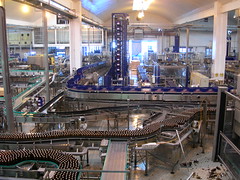
Way back in the day, Henry Ford created something radical: an assembly line. By arranging workflows, workers, and parts, he was able to put together cars much faster than his competition.
What Is An Assembly Line?
According to My Life And Work (Henry Ford and Samuel Crowther, Doubleday, 1922, page 80):
The principles of assembly are these:
- Place the tools and the men in the sequence of the operation so that each component part shall travel the least possible distance while in the process of finishing.
- Use work slides or some other form of carrier so that when a workman completes his operation he drops the part always in the same place which place must always be the most convenient place to his hand and if possible have gravity carry the part to the next workman for his operation.
- Use sliding assembling lines by which the parts to be assembled are delivered at convenient distances.
Most people don't think about applying these principles to everyday life, but they can make a big difference in your rate of productivity.
A Real-Life Task
Recently my family and I picked 20 pounds of strawberries. These berries needed to be washed, hulled, bad spots removed, sliced and packaged. The least efficient means of doing this would be to take a single berry, wash it, hull it, check for bad parts, slice it and put it in the freezer bag.
Instead, I made an assembly line.
The Strawberry Assembly Line
I set up three stations: washing, paring and packaging. The washing station was the sink with a colander to dip the berries out. The paring station was three bowls in a row. The middle bowl was on an old cookie sheet with the bowl itself touching its left-hand neighbor. On the right side of the cookie sheet was the third bowl. The packaging station was a deep bowl with a freezer zipper bag in it. Next to the station were the sugar canister, extra bags and a permanent marker.
The workflow went like this:
- Tip the basket of berries into the sink of cool water and swish around.
- Take a colander of berries and put it in a bowl (the left-most bowl from the paring station, brought to the sink), then move to the paring station.
- Take a berry from the left bowl, remove the hull and drop it in the middle bowl. Drop the hull on the empty part of the cookie sheet. Repeat until all the berries in the left bowl are hulled.
- Take up a knife and a berry from the middle bowl. Slice out any bad spots, dropping the waste on top of the hulls, and slice it into the right-most bowl. Repeat until all the berries in the middle bowl are hulled.
- Repeat steps 2,3,4 until the right-most bowl is filled. Then carry that bowl to the packaging station.
- Ladle sliced berries into a freezer bag. Add a little sugar, seal the bag and put a new bag in the deep bowl. Repeat.
- When all berries are in bags, label the bags with the year and transfer to the freezer.
Applying Assembly Lines To Real Life
Most of the things we do are not this repetitive in nature. But we can still apply assembly lines whenever possible. Here are some examples:
- Keep kitchen supplies grouped together so that nothing has to be moved great distances while cooking. Keep all your baking supplies together, all your like pots and pans together, and your spice s together.
- When cleaning a room, start from the top and let gravity carry the dirt lower so it can be cleaned on subsequent passes through the room.
- Keep your cleaning tools together. Take them as a group into the room you are cleaning.
- Process all your emails at once, and do other like tasks together. Instead of making 5 trips to the copier, make one and copy five things.
http://www.simpleproductivityblog.com/boost-productivity-using-assembly-line-techniques/?utm_source=feedburner&utm_medium=email&utm_campaign=Feed%3A+Simpleproductivityblog+%28SimpleProductivityBlog.com%29
No comments:
Post a Comment